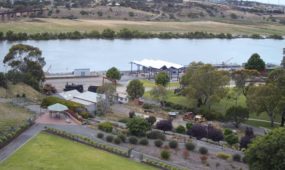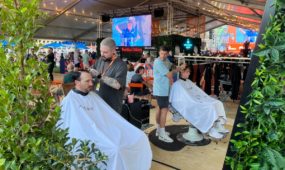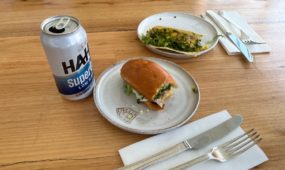Outlaw on an ostrich helps revive lake town
Tourism
THE tale of an undersized bushranger who rode around on an ostrich robbing travellers at gunpoint is helping to put an Australian town crippled by drought back on the map.

Sign up to receive notifications about new stories in this category.
Thank you for subscribing to story notifications.
The South Australian community of Meningie on the banks of Lake Albert about 150km southeast of Adelaide was hit hard by the Millennium Drought, which gripped much of Australia from 2006 to 2010.
The water level in the lake dropped significantly, leading to a spike in salinity, which devastated the local fishing, dairy and tourism industries.
Rather than sit back and watch their town die, the Meningie Progress Association has revived the legend of John Francis Peggotty as part of a long-term project to generate interest in the area and lift community spirits.
Born prematurely in County Limerick, Ireland, in 1864, Peggotty only grew to the height of a seven-year-old child. He spent some time in South Africa, where ostriches were commonly ridden, before moving to Australia.
After settling in Adelaide he is said to have recruited a gang of boys and together they slid down chimneys and stole jewellery, which Peggotty wore proudly all over his body.
The gang disbanded and Peggotty was next seen draped in jewellery and brandishing pistols while perched on the back of an ostrich in the Meningie area.
He was credited with more than a dozen hold-ups and the murder of two travellers before attempting to rob Henry Carmichael as he pulled to shore from a day of fishing on the Coorong, an estuary flanked by sand dunes, on September 17, 1899.
Peggotty fired twice at the fisherman but then fled on his ostrich when Carmichael produced a rifle. Carmichael set off after Peggotty on a horse he had tethered by the shore but was no match for the ostrich, which excelled in the soft sand. So he instead took aim from a distance and fired several shots, hitting the ostrich and Peggotty as he reached the top of a distant sand dune.
When Carmichael finally reached the top of the dune he found the dead ostrich, a broken gold chain worn by Peggotty and a trail of blood leading into the scrub.
The eccentric bushranger was never seen again but his stash of gold chains and jewels are said to be buried deep in the Coorong.
The Birdman of the Coorong statue of Peggotty’s saddled ostrich was unveiled on the Meningie foreshore in May 2013. It has since lured hundreds of passersby to pose for photos while perched in the saddle.
Meningie Progress Association member Denice Mason said the legend of John Francis Peggotty came to light through a decades-old magazine article titled “Birdman of the Coorong” that was found when the town put out a call for local stories to help generate interest in the area.
The association then did some research to confirm parts of the story such as the existence of a bushranger named John Francis and the presence of ostriches in the Coorong from the late 1870s. The exotic, flightless birds were farmed locally to provide feathers for the fashion industry before being set loose because of a failed market. Sightings of the wild birds continued in the area until at least the 1950s.
“When we lost the water out of the lake, Meningie was becoming a dying town and tourism was probably the only thing that could get it back on the map but without water we had to find some other ways,” Mason said.
“The number of people who stop and take a photo here is amazing really.”
Replica artefacts such as Peggotty’s pistol, a broken gold chain and a bullet fired by Carmicheal in the pursuit are dotted around businesses in the town to help generate interest in the legend.
Mason said the location of the steel statue by the water’s edge was also a chance to show off Lake Albert’s beauty.
“This time of year there are these stunning sunsets over the water so it makes for great photos … sometimes you see five or six people trying to pile on there,” she said.
Lake Albert and its larger neighbour Lake Alexandrina are also known as the lower lakes and are fed by Australia’s longest river The Murray.
The Coorong, a 140km long protected lagoon ecosystem surrounded by vast sand dunes is a few kilometres to the west of Meningie.
The town with a population of about 900 has long been a popular toilet stop for people travelling from Adelaide to the Coorong National Park or to the seaside holiday towns of Robe and Kingston.
“Meningie is famous for the toilets in the main street – people then get back in their cars and move on so the main driver was trying to get people to stop a little bit longer and buy a cup of coffee or whatever and I think that’s working,” Mason said.
Other quirky local stories are planned to be rolled out in the future as part of a history trail in the area.
Mason said as well as helping to generate interest in the town, the ostrich statue was also playing a role in lifting the spirits of the community.
“Don’t take it all too seriously I guess, is part of the message,” she said.
“If we can keep visitors coming into the town then it gives people a bit of hope.
“We’re pretty lucky to still have a hospital and doctors who live here and an area school and we don’t want to lose that.”
Meningie will mark its 150th anniversary as a settlement with a weekend of celebrations on October 29 and 30.
Jump to next article



